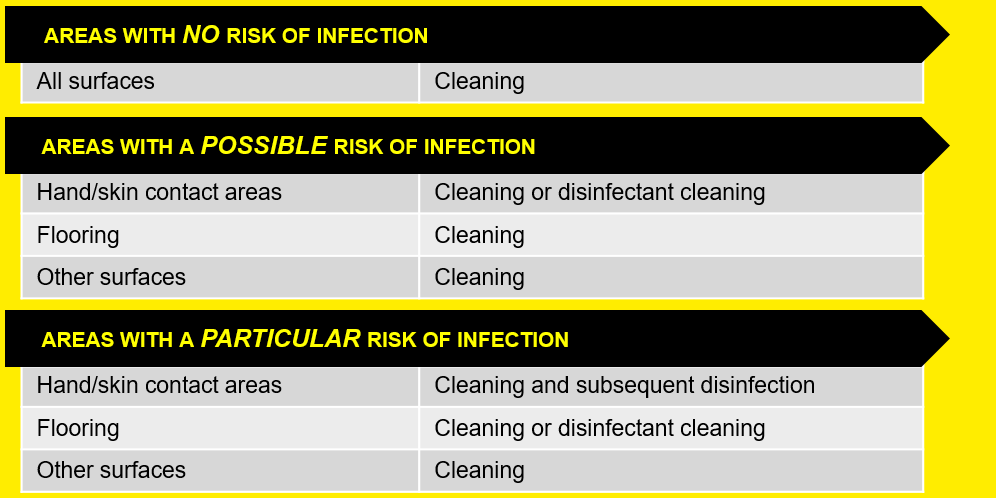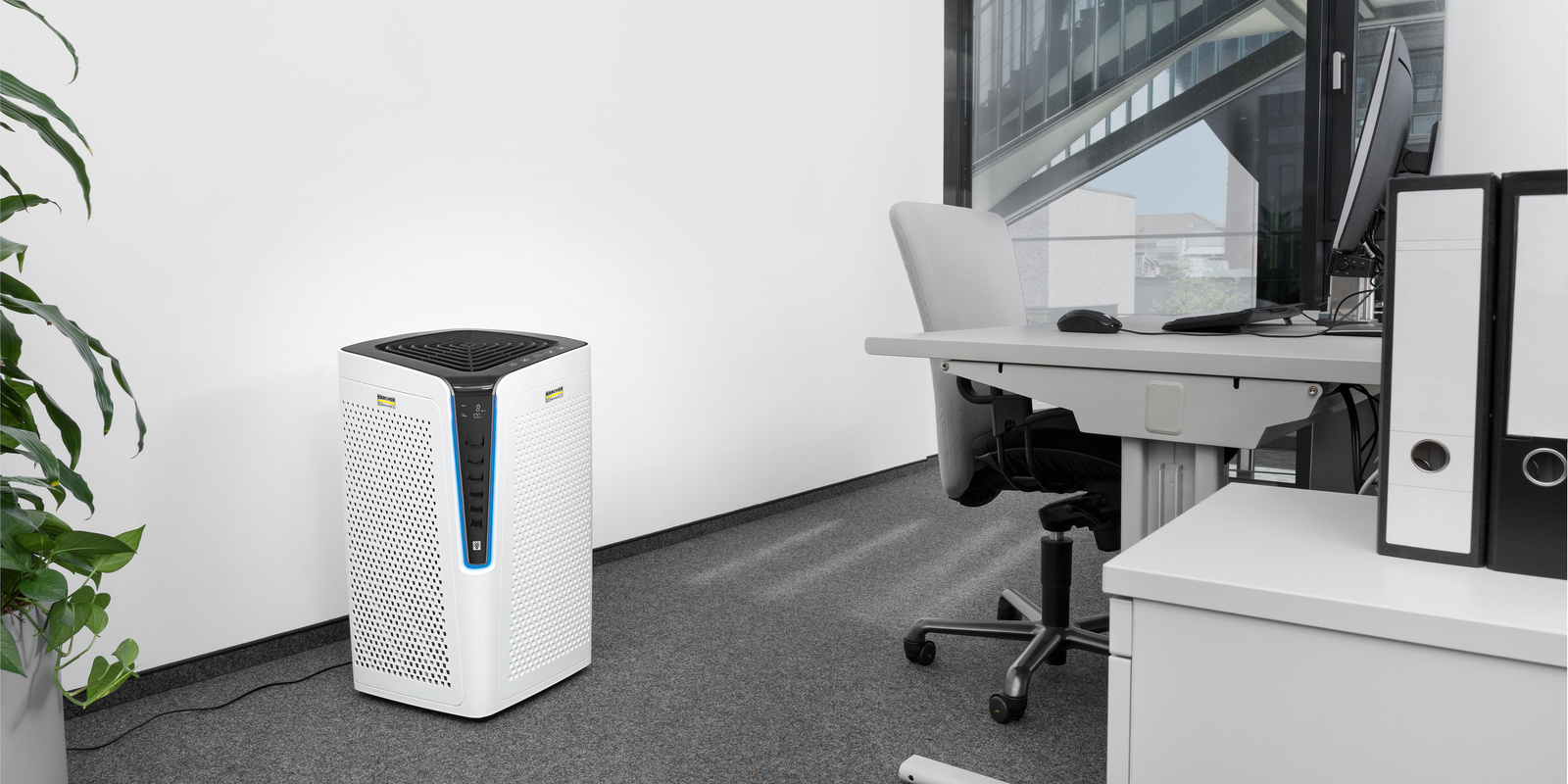Assess the hygiene risk in your facility
The key to success: It's all about infection prevention.
A comprehensive site and risk assessment produces a framework for wellbeing that helps to establish trust among occupants. The extent of cleaning, sanitising and disinfection measures is determined.
Kärcher hygiene solutions – the right choice
The right cleaning approach for every challenge – but how do you choose the appropriate measure? The Kärcher hygiene portfolio offers a great number of cleaning solutions to combat viruses, bacteria and spores. To create a hygienic and safe environment – everywhere!
Standard cleaning is the removal or reduction of undesired substances or foreign matter such as dirt or soil from a surface, object or environment. When cleaning buildings, the objective is typically to have visually clean and well-maintained floors and surfaces.
Cleaning does not kill micro-organisms or render them inactive, which is also not the aim of this process. However, by removing them, cleaning lowers their numbers and the risk of spreading infection. It is therefore the necessary first step to solve post-pandemic hygienic cleaning challenges.
Sanitising is the right approach for areas where hygiene is critical (i.e. washrooms, frequently touched surfaces, areas where people gather, etc.). During an infection outbreak, you may be asked to ensure an increased level of hygiene and safety for the tenants and visitors in a building. Frequently sanitising the air and all touch points, both indoors and outdoors, during the opening hours of a public facility reduces the risk of spreading infectious diseases.
Targeted disinfection or decontamination is necessary after a known outbreak of an infectious disease in a facility or to ensure a hygienic environment in high risk areas such as healthcare or food production*. Please note that without prior cleaning, disinfection is not efficient.
*Note: The continuous use of disinfecting chemicals should only be considered after consulting an infection prevention specialist.
Choose an appropriate, effective and cost-efficient solution that suits to your on-site conditions here or contact us for an individual recommendation.
Risk assessment
What needs to be done and where?

PATHOGENS

What you need to know about pathogens
Viruses
Viruses are made up of a piece of genetic code protected by a coating of protein. Viruses invade host cells and then use the components of the host cell to replicate, producing more viruses. They are not living matter and cannot reproduce by themselves. Preventing their transfer from host to host is an effective way to control their spread.
Bacteria
Bacteria are able to live in just about any environment, including in and on the human body. They take in nutrients and reproduce by dividing. Controlling the conditions they need to grow and reproduce is an effective way to limit their spread.
Fungi
There are millions of different fungal species on Earth. Fungi can be found just about everywhere in the environment, including indoors, outdoors and on human skin. Controlling the conditions they need to grow and reproduce is an effective way to limit their spread.
Pathogen transmission
Pathogen transmission can be categorised into two risk areas which are relevant for cleaning and disinfection in Facility Services:
1. Airborne transmission
An infected person or animal releases pathogen-loaded aerosols by breathing, coughing, sneezing, talking, singing, etc. The pathogens remain contagious for some time and can be inhaled by other organisms. The concentration of the pathogen load in aerosols plays an important role in the transmission of the pathogen
2. Contact transmission
Pathogens can sit and survive on surfaces, where they are picked up by contact and then transferred to the human body. Typical examples of places where this occurs are door handles, handrails or cellphones
Rendering pathogens inactive
Pathogens can be destroyed or rendered inactive using chemical or physical measures. In both cases, the length of exposure to the cleaning process plays an important role.
Removing pathogens from surfaces and destroying them/rendering them inactive:
- Pathogens are removed mechanically, for example using microfibre wipes or a scrubber dryer. The disinfectant in the wipes or machine tank, the laundry process for textiles or the steam in steam cleaner accessories ensure that the pathogens are destroyed/rendered inactive chemically, chemical-thermally or thermally, respectively.
- This is an ideal approach for smooth surfaces (such as tables, doors, glass surfaces, etc.) or frequently touched surfaces (e.g. handles, terminals, controls, etc.).
- Dead/inactive pathogens typically end up in waste water
Destroying pathogens or rendering them inactive directly on the surfaces (without prior removal):
- Chemical measures (disinfectants, alcohol, bleach, ozone, etc.) or physical measures (temperature, steam, plasma, etc.) are applied to a surface and left for the required exposure time.
- This is an ideal approach for irregular surfaces (e.g. rough or structured surfaces, with grouts and joints) or large surfaces, where it can be ensured that the required contact time in hot or humid conditions can be provided.
- Dead/inactive pathogens are either left on the surface (becoming part of common dust to be removed during the next standard cleaning cycle) or rinsed off. In kitchen or food processing areas, they must be rinsed using drinking water.
SANITISING

Sanitising – use facilities safely
Sanitising reduces the number of germs on surfaces or objects to a safe level, according to public health standards or requirements. Sanitising is the right approach for areas where hygiene is critical, or during an infection outbreak, in order to ensure safe hygiene for tenants and visitors in a facility. Frequently sanitising the air and all touch points, both indoors and outdoors, during opening hours reduces the risk of spreading infectious diseases.
Note:
Government regulations on safe behaviour must always be followed (e.g. personal protection equipment (PPE), social distancing, hand hygiene, face coverings, etc.)
Government regulations concerning hygiene measures for specific applications in areas where hygiene is critical must always be followed (e.g. healthcare, food processing, etc.).
What does "sanitising" mean?
Sanitising is a reduction in the number of germs through preventive and disinfectant cleaning measures. Similar to "routine disinfection", which is also known as "current disinfection" or "prophylactic disinfection".
Compared to disinfection and sterilization: No defined or complete germ reduction is required as a result of sanitising.
What to do and when
The risk of pathogen transfer increases with the number and type of contacts. Infection prevention through hygienic cleaning and sanitising can reduce exposure to infectious pathogens:
No contact with people (e.g. home office)
- Regular cleaning
Few contacts, always with the same, known people (e.g. workplace)
- Daily hygienic cleaning of all surfaces
- Sanitising of touch points as required
- Air purification in closed areas and where people meet
Random public footfall (e.g. supermarkets, public transport)
- Daily hygienic cleaning/sanitising of all surfaces
- Frequent cleaning and disinfection of all touch points
- Air purification in closed areas and where people meet
- Use of micro filters (HEPA 14) in vacuum cleaners
Choose an appropriate, effective and cost efficient solution that suits your on-site conditions.
Typical applications include (but are not limited to)
- Frequent wiping of touch points using a disinfectant/cleaning agent in public areas
- Steam cleaning in washroom, gym and spa areas after each guest
- Treatment of touch points on transport racks and trolleys
DISINFECTION

Disinfection or decontamination – restore a facility after an outbreak situation
Targeted disinfection or decontamination is necessary after a known outbreak of an infectious disease in a facility or to ensure a hygienic environment in high risk areas such as healthcare or food production sites. Governments or similar public authorities may mandate a targeted disinfection process in some cases.
What needs to be disinfected?
A pandemic situation is not the same as an outbreak situation in a building. In the case of a pandemic, not all buildings are necessarily populated with pathogenic germs. In the event of an outbreak in a building, where it has been proven that people with a pathogen infection were at least on site and that there may be pathogenic germs on surfaces and floors, disinfection in some areas becomes necessary.
Examples
- According to the RKI recommendations, even in the patient areas, hospital disinfection is only necessary on areas with frequent skin and hand contact. This means that every touch point, such as light switches, door handles, bedside tables, AC controls or similar objects, must be disinfected
- Other surfaces, such as floors, ceilings, walls, and lamps, do not need to be disinfected; cleaning is sufficient here
- Floors in hospitals where COVID-19 patients reside must be disinfected
What does "disinfection" mean?
- Killing all pathogenic germs or rendering them all inactive
- No risk of infection via the disinfected surface
- Reduction of 99.99% viruses/99.999% bacteria
- Designed to kill actively growing and vegetative microbial micro-organisms to a certain level*.
- Disinfection is similar to "targeted disinfection"
Important notes:
1. Clean first → If a surface is not clean, a disinfectant solution does not guarantee effective disinfection
2. Ensure accuracy → Use any disinfecting measure carefully and according to the instructions of use to ensure a hygienic result
3. Avoid overkill → The continuous use of disinfecting chemicals should only be considered after consulting an infection prevention specialist
Terminology
- Bactericidal → effective against all bacteria
- Fungicidal → effective against fungi
- Levurocidal → effective against yeasts
- Limited virucidal → effective against all enveloped viruses
- Unlimited virucidal plus → effective against all enveloped and non-enveloped viruses
- Sporicidal → effective against the spores of "bacterial spore formers"
Application advice – your tailored Kärcher hygiene solutions
Hygiene solutions for your industry
Discover our holistic hygienic solutions for the facilities in your business environment. As part of our consulting service, we support you on-site with the implementation of requirements for hygienic safety and infection prevention – including detailed and comprehensive training materials.





